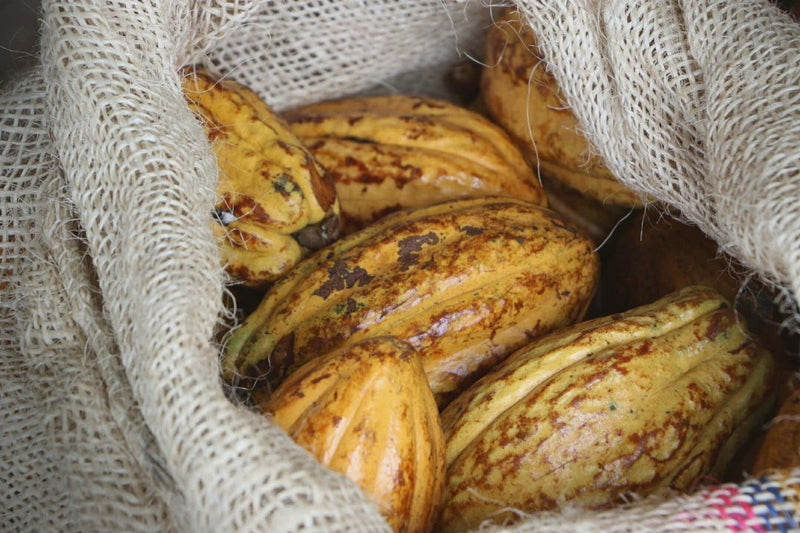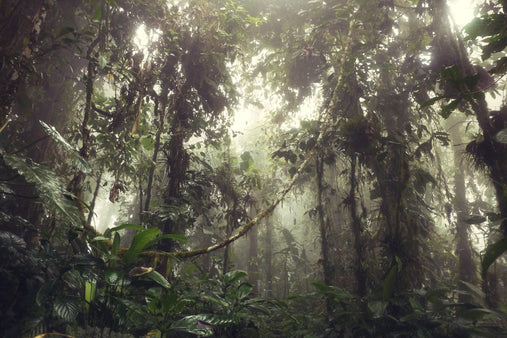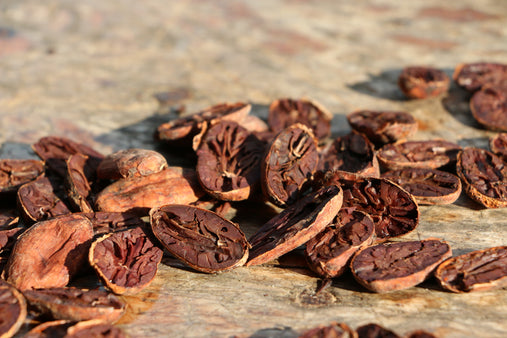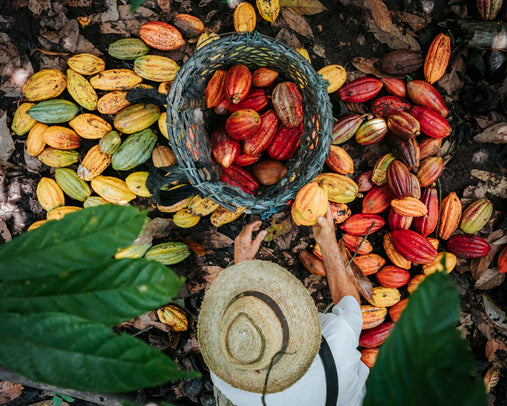
11th of January 2021
The next time you’re anxiously unwrapping a piece of fine chocolate, take a few seconds to let your mouth salivate and think about what it took for that bar to reach your hands.
Here’s a quick overview: Before being beautifully molded into a chocolate bar, cacao pods are carefully harvested by hand, often with a machete, and opened to reveal roughly 20-50 beans (approximately 400 beans can make one pound of chocolate). The beans are then fermented, dried, sorted, cleaned, roasted, winnowed, ground, conched, and tempered.
Each part of this process can be painstakingly meticulous—that is, if you want to maintain the rich, earthy, unique nuances of each precious bean. Because chocolate (or candy products that liberally use the word “chocolate”) is available nearly everywhere, we often don’t think of it as a high-end, high-quality product. Fortunately, this mindset is starting to shift.
The rise of fair trade organizations has been a good start in addressing this hard work. But even certified fair trade chocolate doesn’t always cover all the bases. A lack of transparency and limited oversight of cacao farms worldwide has meant that issues of child and slave labor, deforestation, and other unsustainable practices still run rampant in the chocolate industry.
Direct trade chocolate goes even further to strengthen the connection between chocolate companies and cocoa farmers. But a fully sustainable chocolate is one that concentrates most (if not all) of its efforts and profits right at the source. This is the philosophy of To’ak and one that guarantees fair pay, healthy practices for both farmers and the environment, and—of course—exceptional chocolate.
For more details on how much we pay the cacao growers we work with, please refer to our Annual Transparency Report. When measured in terms of an FOB Export price for dry cacao (the industry standard pricing mechanism), we pay USD $8,818 to $22,046 per metric ton, which is 270% to 820% above the Fair Trade minimum price. As far as we know, this is the highest price that any chocolate company pays for cacao in the world.
That said, let’s dive a little deeper into the future of fair trade, direct trade, and sustainable chocolate.

A Chocolate Revolution
Over the last several years, chocolate has experienced a minor revolution as businesses commit to ending deforestation and child labor. But this multi-billion dollar industry still has a ways to go. Most of the world’s cocoa beans (about 80%) originate in West Africa, while the rest come from Latin America and Asia. Until recently, almost none of these areas within the “cocoa belt” actually made chocolate due to lack of resources and the extra challenges of producing bars in sticky tropical climates. Almost all major chocolate corporations are based in the U.S. and Europe, often making for a long, convoluted supply chain with barely any oversight at the source.
The use of slave and child labor on West African cocoa farms has been well-documented. Around the turn of the century, companies like Hershey, Nestle, and Mars pledged to put an end to this exploitation. But many of the world’s top chocolate manufacturers still don’t even know where their cocoa beans come from. In 2019, The Washington Post reported that Mars could only trace 24% of its global cocoa supply back to farms, while Hershey and Nestle did slightly better at just under 50%.
The report also found that the industry had only spent some $150 million over 18 years on trying to eradicate slave and child labor. That same year, Hershey, which makes up about 45% of the entire chocolate market, posted a net income of $1.15 billion. In early 2020, the company announced that they finally met their promise to use 100% certified fair trade and sustainable cocoa by sourcing from cocoa suppliers certified by organizations such as Fairtrade USA and Rainforest Alliance. But many people are still skeptical of how much of Hershey’s profits are actually going into farmers’ hands and what “fair trade” really means.

What is Fair Trade Chocolate?
Fair trade chocolate aims to address social, environmental, and economic challenges around deforestation, climate change, slave and child labor, systemic poverty, and social inequity. Fairtrade and Rainforest Alliance are two nonprofit groups that offer official Fair Trade certification for chocolate. Each organization has slightly different guidelines and approaches when it comes to promoting fair and sustainable practices:
Rainforest Alliance:
Rainforest Alliance’s mission is “to create a more sustainable world by using social and market forces to protect nature and improve the lives of farmers and forest communities.” The program mainly focused on environmental protection and conservation, but, after merging with the former certification program UTZ in 2018, they’ve established a new 2020 Certification Program, which will take effect in July 2021. Farm and supply chain requirements will focus more on fair wages, requiring that workers receive “at least the minimum wage based on a 48-hour working week or national legal working hours limit, whichever is lower.”
Fairtrade:
Fairtrade’s mission is “to connect disadvantaged producers and consumers, promote fairer trading conditions and empower producers to combat poverty, strengthen their position and take more control over their lives.” Their main focus is on fair wages and guaranteeing that cocoa producers receive a “Fairtrade Minimum Price,” which increases with organic production. The program also offers a Fairtrade Premium that gives farmers extra money to invest in their business.

Problems with Fair Trade
Chocolate bars that feature a Fairtrade or Rainforest Alliance label should provide the consumer with some reassurance that they’re enjoying cocoa sourced from farms that are paying fair wages and promoting sustainable practices for the health of both the workers and the environment.
While this mission is noble, its execution has been rife with problems. Physically going to every farm to ensure that it’s following the certification guidelines is nearly impossible, especially given that most cacao farms are small. If a farm is checked, inspections are typically scheduled in advance (so farms can prepare for a visit) and, according to that Washington Post exposé, fewer than 10% of farms are inspected annually. Rainforest Alliance’s new certification program ups the auditing requirements to at least 33% of large farms every year (small-scale producers can still often fall through the cracks). Fairtrade itself recognizes a recent report from the US Department of Labor that found that more than two million children are working on cocoa farms across West Africa—which includes many certified farms.
Another issue with fair trade is that a lot of small chocolate producers don’t have the time, money, or resources to seek out and maintain an official certification to have that stamp of approval on their products. But it doesn’t mean they’re not practicing ethical sourcing of their cocoa beans. They may be doing even more...

What is Direct Trade Chocolate?
Direct trade (sometimes referred to as “bean to bar”) chocolate goes several steps beyond fair trade. When a chocolate company commits to direct trade, it means they have a direct relationship with the farmers and cooperatives who source their cacao. There are no middlemen, no nebulous third-party auditors who end up taking a significant cut of the profits. Direct access to farms often means you get top choice in beans at a reasonable price.
The direct trade ideology is more akin to a small business: there are far fewer complexities and potential problems in the supply chain. Direct trade allows for a stronger, more symbiotic relationship: both the farmer and buyer are dependent on each other’s ethics, quality, and success.
This philosophy leads to higher wages and often more sustainable, environmentally friendly farming practices. With direct trade, companies are closer to the source, and it often shows in the quality, care, and—yes, price—of their product. While this distinction is important, there’s currently no direct trade certification. Instead, chocolate makers will often include specific details (and sometimes pictures) of the farmers and co-ops they work with right on their packaging.

What is Sustainable Chocolate and Why is It Best?
Direct trade allows for small businesses around the world to make a significant impact on the health of cacao and the chocolate industry. The shorter the supply chain, the better for all. The ideal sustainable chocolate is one that’s manufactured at or near the source, with 100% traceability from tree to bar. To encourage this potential, To’ak recently helped launch Orijin, a digital supply chain traceability platform that can help farmers increase productivity and allow consumers to see exactly where their favorite chocolate is coming from.
Sustainable chocolate is still incredibly rare, but producers like To’ak in Ecuador and Cacaosuyo in Peru are right there on-site, helping to conserve the land, preserve rare ancient cacao varieties, and reward their farmers with the highest wages in the industry. It also makes for some damn fine chocolate.

Featured products
More from us


